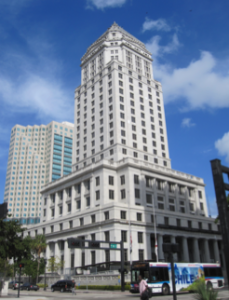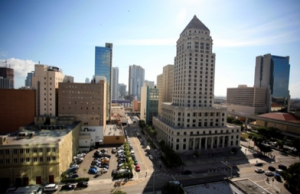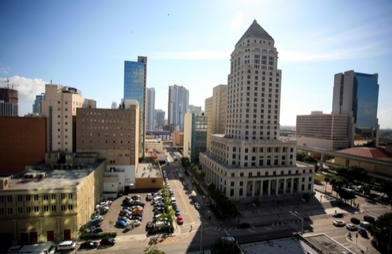The crumbling courthouse crisis has now become a blame game.
Echoing lobbyist Jorge Luis Lopez — who said on the radio  during the campaign for the bond tax for a new courthouse that Miami Mayor Tomas Regalado was at fault for letting the building deteriorate so much — Miami-Dade Commissioner Sally Heyman pointed the finger at the City of Miami and basically put the onus of the historic courthouse’s condition on them.
during the campaign for the bond tax for a new courthouse that Miami Mayor Tomas Regalado was at fault for letting the building deteriorate so much — Miami-Dade Commissioner Sally Heyman pointed the finger at the City of Miami and basically put the onus of the historic courthouse’s condition on them.
Heyman, chair of the county’s Public Safety and Animal Services committee, also asked for an Inspector General to conduct an audit investigation into what happened at Cielito Lindo and how it got so bad.
Read related story: Commissioner Juan Zapata: Close courthouse if there’s a risk
“I’m appalled at the circumstances we are under,” Heyman said, adding that while it was a county building, which is several years overdue on it’s 40-year certification, all inspections and code enforcement fall under the city of Miami’s jurisdiction.
“No one from the city did an inspection. I’d like the Inspector General to take a look at, going back, an audit, of what the circumstances are, what the obligations are and by who,” Heyman said. “I’m not saying it was criminal, though I have my opinion on it. I sure thought it was neglectful. It didn’t come on anybody’s radar because the city of Miami, 16, 18, 20 years later, still didn’t do the 40 inspection that they should have.
“No one is asking who dropped the ball and how could that have been prevented,” she said.
Well, Commissioner Heyman, maybe the Inspector General inquiry should also look into the paid county courthouse manager that maybe was the one who dropped the ball.
There’s a manager for each of the 11 county courthouses, making between $70,000 and $90,000-a-year, to manage what exactly? Had the manager at 73 West Flagler made any efforts to address the rapidly deteriorating condition of the courthouse?
Because there are some in the community who believe that certain people in the county — and the people who benefit from those people’s positions in the county — knew that there were structural concerns and let them go on and on and on until it got to this critical point precisely so that a new courthouse would be more easily sold.
Read related story: Courthouse tax debate: Scare tactics vs. common sense
Those columns didn’t corrode overnight. The flooding isn’t new. The mold and asbestos and termites have been known of for months, if not years.
And just because the community has overwhelmingly rejected the notion that taxpayers should pay for a giant, brand new $393-million courthouse without getting any details as to where and how and why so big, all that hot mess in the historic building doesn’t go away. It still needs to be addressed.
The committee approved a resolution  from Commissioner Juan Zapata to direct the mayor’s office to do an immediate inspection and assessment of the courthouse — and close it down if the conditions are so dire that there are risks to life and health to the almost one million people that go through there a year and the 576 people who work there every day. Commissioner Esteban Bovo wanted to amend it to assess the other 10 courthouses, too, but that was tabled until it goes to the full commission next month.
from Commissioner Juan Zapata to direct the mayor’s office to do an immediate inspection and assessment of the courthouse — and close it down if the conditions are so dire that there are risks to life and health to the almost one million people that go through there a year and the 576 people who work there every day. Commissioner Esteban Bovo wanted to amend it to assess the other 10 courthouses, too, but that was tabled until it goes to the full commission next month.
Chief Miami-Dade Judge Bertila Soto, whose dreams were dashed when voters killed the courthouse tax Tuesday, supported the measure. But she said the commission should go further.
“All of these are great short term requests. However, we need a long-term solution,” Soto said, applauding a proposed amendment by Commissioner Audrey Edmonson directing the mayor’s office to also look into the construction and funding alternatives for a new courthouse.
“This is like an old car. You fix one thing, the next day two other things break down,” Soto said,  citing an elevator that was fixed in October as an example. “It was closed last week again.
citing an elevator that was fixed in October as an example. “It was closed last week again.
“Even if the building were pristine, we all know its inadequate. There are 23 courtrooms for 41 judges. It goes far beyond what was envisioned for this building,” Soto said. “We were going to ask that this commission discuss, at its Dec. 2 meeting, to identify a funding for a long term solution and continue the process to build a new courthouse.
“That’s what the citizens of Dade County deserve. A safe and functioning new courthouse.”
The citizens also deserve answers to the dozens of questions that have come up about how to best use the assets we have now or have access to and any new courthouse space built in the future. They deserve a transparent and open conversation about how we are going to fix this.
Ladra fully expects that conversation to start Dec. 2 when Zap’s request and the accompanying amendments and Edmonson’s reuqest is heard by the whole commission.
Let’s just hope it doesn’t end in yet another bond referendum question next year.

